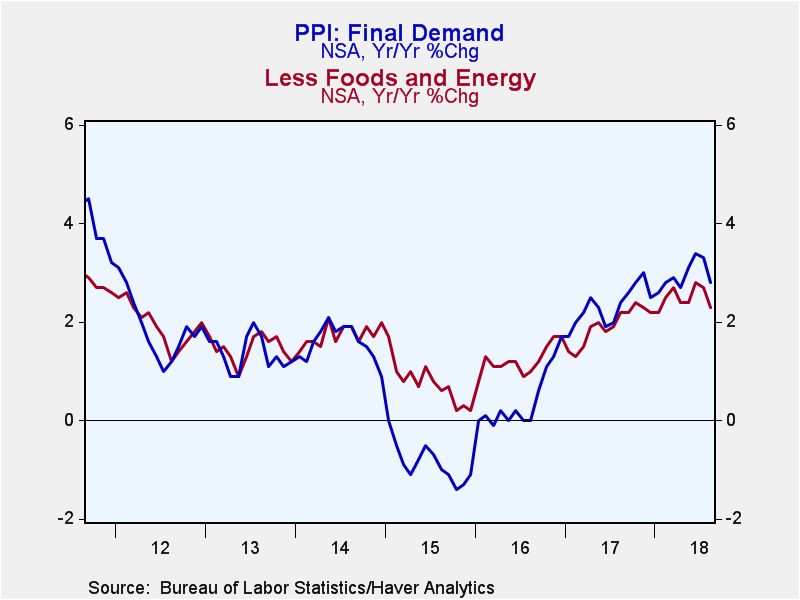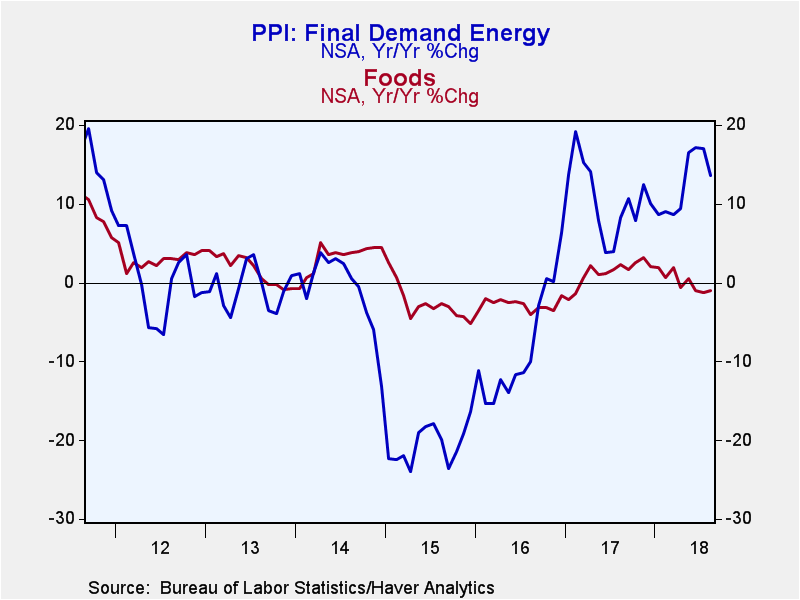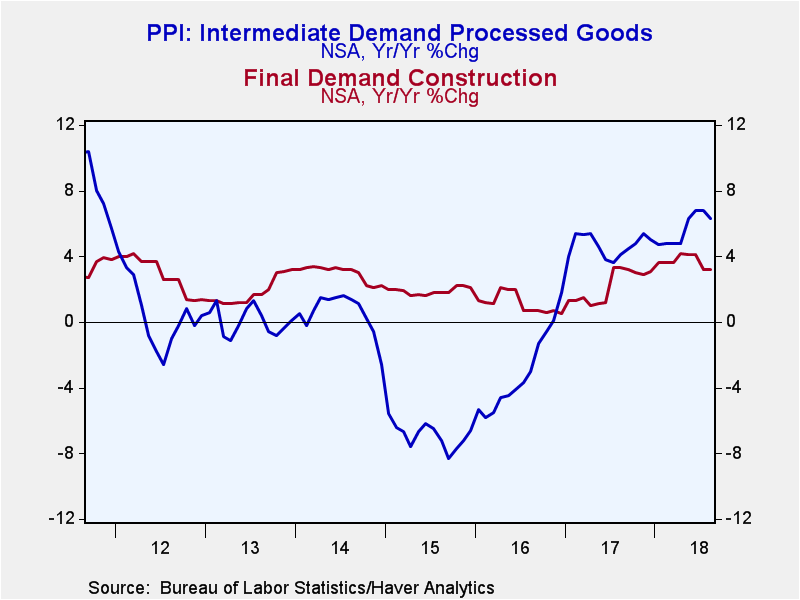 Global| Sep 12 2018
Global| Sep 12 2018U.S. Producer Prices Decline Unexpectedly
by:Tom Moeller
|in:Economy in Brief
Summary
The headline Final Demand Producer Price Index using new methodology eased 0.1% during August (+2.8% y/y) after holding steady in July. It was the first decline since February 2017. A 0.2% increase had been expected in the Action [...]
The headline Final Demand Producer Price Index using new methodology eased 0.1% during August (+2.8% y/y) after holding steady in July. It was the first decline since February 2017. A 0.2% increase had been expected in the Action Economics Forecast Survey. The PPI excluding food & energy also slipped 0.1% (+2.3% y/y) and reversed the July gain. A 0.2% rise had been expected. The PPI excluding food, beverages and trade services is another measure of underlying price inflation. It rose 0.1% (2.9% y/y) in August following two months of 0.3% increase.
The PPI using the old methodology held steady (3.6% y/y) following a 0.2% gain. Prices excluding food & energy eased 0.1% (+2.4% y/y) after a 0.2% rise.
A 0.9% decline (+0.8% y/y) in trade services prices provided downward pressure on the overall PPI last month. It followed a 0.8% shortfall in July. The cost of trade of finished products fell 0.8% (+0.5% y/y) for the second straight month. Trade of government purchased goods dropped 1.1% (+0.7% y/y), down for the third consecutive month. Passenger transportation prices slipped 1.9% (+3.0% y/y) while transportation & warehousing of goods costs eased 0.1% (+6.4% y/y).
Goods prices excluding food & energy held steady last month following six months of 0.3% increase earlier this year. The 2.7% y/y rise followed slight y/y declines as of late-2015. Core nondurable goods pries were unchanged (+3.3% y/y), but durable goods prices gained 0.1%, the weakest increase in six months. Price increases for durables have accelerated to 1.9% y/y from little-change in mid-2016. Household furniture prices increased 0.1% (2.6 y/y) but appliance costs declined 0.1% (+2.8% y/y). Capital equipment prices rose 0.2% m/m. The 1.9% y/y increase also was accelerated from 0.3% as of mid-2016. Government purchased goods prices less food & energy rose 0.2% and increased 2.3% y/y, following price deflation in 2016.
Food prices also weakened during August by 0.6% (-1.0% y/y), the fourth decline in the last five months. Fresh fruit & vegetable prices dropped 11.3% (+0.1% y/y) while beef & veal prices weakened 1.9% (-4.3% y/y). Dairy product costs declined 1.2% (-3.7% y/y) for a second straight month. Offsetting these declines was a 4.5% rise (8.1% y/y) in grain prices. Energy product prices rose 0.4% (13.6% y/y) as natural gas prices strengthened 1.8% (0.0% y/y). Gasoline prices rose 0.6% (28.1% y/y) and the cost of electric power also increased 0.6% (1.5% y/y). Home heating oil prices declined 0.9% (+39.6% y/y).
Construction prices inched 0.1% higher (3.2% y/y) following a 0.4% rise.
Prices for intermediate demand processed goods held steady (6.3% y/y) for the second straight month. Monthly price increases during Q2 ranged between 0.4% and 1.3%.
The PPI data are contained in Haver's USECON database with further detail in PPI and PPIR. West Texas Intermediate Crude Oil prices are found in the WEEKLY database while the expectations figures are available in the AS1REPNA database.
What Do We Mean by Neutral and What Role Does It Play in Monetary Policy? from Fed Governor Lael Brainard can be found here.| Producer Price Index (SA, %, New Methodology) | Aug | Jul | Jun | Aug Y/Y | 2017 | 2016 | 2015 |
|---|---|---|---|---|---|---|---|
| Final Demand | -0.1 | 0.0 | 0.3 | 2.8 | 2.3 | 0.4 | -0.9 |
| Excluding Food & Energy | -0.1 | 0.1 | 0.3 | 2.3 | 1.9 | 1.2 | 0.8 |
| Excluding Food, Energy & Trade Services | 0.1 | 0.3 | 0.3 | 2.9 | 2.1 | 1.2 | 0.6 |
| Goods | 0.0 | 0.1 | 0.1 | 3.9 | 3.3 | -1.4 | -4.3 |
| Foods | -0.6 | -0.1 | -1.1 | -1.0 | 1.2 | -2.8 | -2.6 |
| Energy | 0.4 | -0.5 | 0.8 | 13.6 | 10.4 | -8.4 | -20.6 |
| Goods Excluding Food & Energy | 0.0 | 0.3 | 0.3 | 2.7 | 2.2 | 0.7 | 0.4 |
| Services | -0.1 | -0.1 | 0.4 | 2.2 | 1.8 | 1.4 | 0.9 |
| Trade Services | -0.9 | -0.8 | 0.7 | 0.8 | 1.5 | 1.3 | 1.3 |
| Construction | 0.1 | 0.4 | 0.2 | 3.2 | 2.2 | 1.1 | 1.9 |
| Intermediate Demand - Processed Goods | 0.0 | 0.0 | 0.7 | 6.3 | 4.7 | -3.1 | -6.9 |
Tom Moeller
AuthorMore in Author Profile »Prior to joining Haver Analytics in 2000, Mr. Moeller worked as the Economist at Chancellor Capital Management from 1985 to 1999. There, he developed comprehensive economic forecasts and interpreted economic data for equity and fixed income portfolio managers. Also at Chancellor, Mr. Moeller worked as an equity analyst and was responsible for researching and rating companies in the economically sensitive automobile and housing industries for investment in Chancellor’s equity portfolio. Prior to joining Chancellor, Mr. Moeller was an Economist at Citibank from 1979 to 1984. He also analyzed pricing behavior in the metals industry for the Council on Wage and Price Stability in Washington, D.C. In 1999, Mr. Moeller received the award for most accurate forecast from the Forecasters' Club of New York. From 1990 to 1992 he was President of the New York Association for Business Economists. Mr. Moeller earned an M.B.A. in Finance from Fordham University, where he graduated in 1987. He holds a Bachelor of Arts in Economics from George Washington University.










